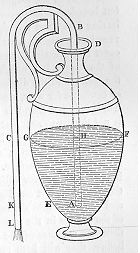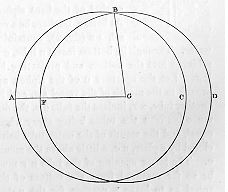Let A B C, (fig. 1), be a bent siphon, or tube, of which the leg A B is plunged into a vessel D E containing water.
If the surface of the
 water is in F G, the leg of the siphon, A B, will be filled with water as
high as the surface, that is, up to H, the portion H B C remaining full
of air. If, then, we draw off the air by suction through the aperture
C, the liquid also will follow from the impossibility, explained above,
of a continuous vacuum. And, if the aperture C be level with the surface
of the water, the siphon,C though full, will not discharge the water,
but will remain full: so that, although it is contrary to nature for
water to rise, it has risen so as to fill the tube A B C; and the water
will remain in equilibrium, like the beams of a balance, the portion H B
being raised on high,and the portion B C suspended. But if the outer
mouth of the siphon be lower than the surface F G, as at K, the water
flows out; for the liquid in K B, being heavier, overpowers and draws
toward it the liquid in B H. The discharge, however, continues only
until the surface of the water is on a level with the mouth K, when, for
the same reason as before, the efflux ceases. But if the outer mouth of
the tube be lower than K, as at L, the discharge continues until the
surface of the water reaches the mouth A. If then we wish all the water
in the vessel to be drawn out, we must depress the siphon so far that
the mouth A may reach the bottom of the vessel, leaving only a passage
for the water.
water is in F G, the leg of the siphon, A B, will be filled with water as
high as the surface, that is, up to H, the portion H B C remaining full
of air. If, then, we draw off the air by suction through the aperture
C, the liquid also will follow from the impossibility, explained above,
of a continuous vacuum. And, if the aperture C be level with the surface
of the water, the siphon,C though full, will not discharge the water,
but will remain full: so that, although it is contrary to nature for
water to rise, it has risen so as to fill the tube A B C; and the water
will remain in equilibrium, like the beams of a balance, the portion H B
being raised on high,and the portion B C suspended. But if the outer
mouth of the siphon be lower than the surface F G, as at K, the water
flows out; for the liquid in K B, being heavier, overpowers and draws
toward it the liquid in B H. The discharge, however, continues only
until the surface of the water is on a level with the mouth K, when, for
the same reason as before, the efflux ceases. But if the outer mouth of
the tube be lower than K, as at L, the discharge continues until the
surface of the water reaches the mouth A. If then we wish all the water
in the vessel to be drawn out, we must depress the siphon so far that
the mouth A may reach the bottom of the vessel, leaving only a passage
for the water. Now some writers have given the above explanation of the action of the siphon, saying that the longer leg, holding more, attracts the shorter. But that such an explanation is incorrect, and that he who believes so would be greatly mistaken if he were to attempt to raise water from a lower level, we may prove as follows. Let there be a siphon with its inner leg longer and narrow, and the outer much less in length but broader so as to contain more water than the longer leg. Then, having first filled the siphon with water, plunge the longer leg into a vessel of water or a well. Now, if we allow the water to flow, the outer leg, containing more than the inner, should draw the water out of the longer leg, which will at the same time draw up the water in the well ; and the discharge having begun will exhaust all the water or continue for ever, since the liquid without is more than that within. But this is not found to be the case; and therefore the alleged cause is not the true one. Let us then examine into the natural cause. The surface of every liquid body, when at rest, is spherical and concentric with that of the earth; and, if the liquid be not at rest, it moves until it attains such a surface. If then we take two vessels and pour water into each, and, after filling the siphon and closing its extremities with the fingers, insert one leg into one vessel plunging it beneath the water, and the other into the other, all the water will be continuous, for each of the liquids in the vessels communicates with that in the siphon. If, then, the surfaces of the liquids in the vessels were at the same level before, they will both remain at rest when the siphon is plunged in. But if they were not, as soon as the water is continuous it must inevitably flow into the lower vessel through the channel of communication, until either all the water in both vessels stands at the same height, or one of the vessels is emptied. Suppose that the liquids stand at the same height; they will of course be at rest, so that the liquid in the siphon will also be at rest. If, then, the siphon be conceived to be intersected by a plane in the surface of the liquids in the vessels, even now the liquid in the siphon will be at rest, and, if raised without being inclined to either side, it will again be at rest, and that, whether the siphon is of equal breadth throughout or one leg is much larger than the other. For the reason why the liquid remained at rest did not lie in this, but in the fact that the apertures of the siphon were at the same level. The question now arises why, when the siphon is raised, the water is not borne down by its own weight, having beneath it air which is lighter than itself. The answer is that a continuous void cannot exist ; so that, if the water is to descend, we must first fill the upper part of the siphon, into which no air can possibly force its way. But if we pierce a hole in the upper part of the siphon, the water will immediately be rent in sunder the air having found a passage. Before the hole is bored, the liquid in the siphon, resting on the air beneath, tends to drive it away, but the air having no means of escape does not allow the water to pass out: when however the air has obtained a passage through the hole, being unable to sustain the pressure of the water, it escapes.
 It is from the same cause that, by means of a siphon, we can
suck wine upwards, though this is contrary to the nature of a liquid;
for, when we have received into the body the air which was in the
siphon, we become fuller than before, and a pressure is exerted on the
air contiouous to us, and this in turn presses on the atmosphere at
large until a void has been produced at the surface of the wine, and
then the wine undergoing pressure itself will pass into the exhausted
space of the siphon ; for there is no other place into which it can
escape from the pressure. It is from this cause that its unnatural
upward movement arises. That the water in the siphon will rest when its
surface is spherical and concentric with that of the earth may be shewn
otherwise. It is required to prove that a liquid is stationary when its
surface is spherical and concentric with that of the earth. If possible
let it not be stationary; it will of course become so after being moved;
let it then have become stationary. Its surface will now be spherical
and concentric with that of the earth, and it will cut the former
surface , for, when the same liquid has taken two positions, there must
be a line of intersection common to both. Let both surfaces be cut by a
plane passing through the centre of the earth ; the intersections will
be the circuinferences of circles concentric with the earth. Let these
circumferences be A B C and F B D, (fig. 1 a.) Join B G; B G is equal
to each of the lines G F, G A, which is absurd. The liquid will
therefore be in equilibrium
It is from the same cause that, by means of a siphon, we can
suck wine upwards, though this is contrary to the nature of a liquid;
for, when we have received into the body the air which was in the
siphon, we become fuller than before, and a pressure is exerted on the
air contiouous to us, and this in turn presses on the atmosphere at
large until a void has been produced at the surface of the wine, and
then the wine undergoing pressure itself will pass into the exhausted
space of the siphon ; for there is no other place into which it can
escape from the pressure. It is from this cause that its unnatural
upward movement arises. That the water in the siphon will rest when its
surface is spherical and concentric with that of the earth may be shewn
otherwise. It is required to prove that a liquid is stationary when its
surface is spherical and concentric with that of the earth. If possible
let it not be stationary; it will of course become so after being moved;
let it then have become stationary. Its surface will now be spherical
and concentric with that of the earth, and it will cut the former
surface , for, when the same liquid has taken two positions, there must
be a line of intersection common to both. Let both surfaces be cut by a
plane passing through the centre of the earth ; the intersections will
be the circuinferences of circles concentric with the earth. Let these
circumferences be A B C and F B D, (fig. 1 a.) Join B G; B G is equal
to each of the lines G F, G A, which is absurd. The liquid will
therefore be in equilibrium